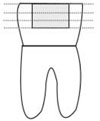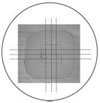Abstract
This study was conducted to evaluate the influence of the C-factor on the bond strength of a 6th generation self-etching system by measuring the microtensile bond strength of four types of restorations classified by different C-factors with an identical depth of dentin.
Eighty human molars were divided into four experimental groups, each of which had a C-factor of 0.25, 2, 3 or 4. Each group was then further divided into four subgroups based on the adhesive and composite resin used. The adhesives used for this study were AQ Bond Plus (Sun Medical, Japan) and Xeno III (DENTSPLY, Germany). And composite resins used were Fantasista (Sun Medical, Japan) and Ceram-X mono (DENTSPLY, Germany).
The results were then analyzed using one-way ANOVA, a Tukey's test, and a Pearson's correlation test and were as follows.
There was no significant difference among C-factor groups with the exception of groups of Xeno III and Ceram-X mono (p < 0.05).
There was no significant difference between any of the adhesives and composite resins in groups with C-factor 0.25, 2 and 4.
There was no correlation between the change in C-factor and microtensile bond strength in the Fantasista groups.
It was concluded that the C-factor of cavities does not have a significant effect on the microtensile bond strength of the restorations when cavities of the same depth of dentin are restored using composite resin in conjunction with the 6th generation self-etching system.
Figures and Tables
 | Figure 1Schematic diagrams of the four groups of restoration that varied according to each C-value.
Groups with C-factor 0.25 were prepared on the flat ground dentin surfaces. For the other experimental groups, the cavities were prepared below the ground dentin surfaces.
|
 | Figure 5Graph of the mean microtensile bond strength (MPa) of the Fantasista groups.
Groups connected with the line are not significantly different according to the one-way ANOVA (p > 0.05)
|
 | Figure 6Graph of the mean microtensile bond strength (MPa) of the Ceram-X mono groups.
Symbols (*) indicate statistically significance at p = 0.05 level
|
References
1. Davidson CL, de Gee AJ. Relaxation of polymerization contraction stresses by flow in dental composites. J Dent Res. 1984. 63:146–148.

2. Davidson CL. Resisting the curing contraction with adhesive composites. J Prosthet Dent. 1986. 55:446–447.

3. Feilzer AJ, de Gee AJ, Davidson CL. Setting stress in composite resin in relation to configuration of the restoration. J Dent Res. 1987. 66:1636–1639.

4. Feilzer AJ, de Gee AJ, Davidson CL. Setting stresses in composites for two different curing modes. Dent Mater. 1993. 9:2–5.

5. Alster D, Feilzer AJ, de Gee AJ, Davidson CL. Polymerization contraction stress in thin resin composite layers as a function of layer thickness. Dent Mater. 1997. 13:146–150.

6. Versluis A, Tantbirojn D, Douglas WH. Do dental composites always shrink toward the light? J Dent Res. 1998. 77:1435–1445.

7. He Z, Shimada Y, Tagami J. The effect of cavity size and incremental technique on micro-tensile bond strength of resin composite in Class I cavities. Dent Mater. 2007. 23:533–538.

8. Uno S, Tanka T, Inoue S. The influence of configuration factors on cavity adaptation in compomer restoration. Dent Mater J. 1999. 18:19–31.

9. Shirai K, Munck JD, Yoshida Y, Inoue S, Lambrechts P, Suzuki K, Shintani H, Meerbeek BV. Effect of cavity configuration and agind on the bonding effectiveness of six adhesives to dentin. Dent Mater. 2005. 21:110–124.

10. Wattanawongpitak N, Yoshikawa T, Burrow MF, Tagami J. The effect of bonding system and composite type on adaptation of different C-factor restorations. Dent Mater J. 2006. 25:45–50.

11. Sano H, Shono T, Sonoda H, Takatsu T, Ciucchi B, Carvalho R, Pashley DH. Relationship between surface area for adhesion and tensile bond strength - Evaluation of a micro-tensile bond test. Dent Mater. 1994. 10:236–240.

12. Nakajima M, Kanemura N, Pereira PN, Tagami J, Pashley DH. Comparative microtensile bond strength and SEM analysis of bonding to wet and dry dentin. Am J Dent. 2000. 13:324–328.
13. Frankenberger R, Perdigao J, Rosa BT, Lopes M. "No-bottle" vs "multi-bottle" dentin adhesives: a microtensile bond strength and morphological study. Dent Mater. 2001. 17:373–380.

14. Yoshikawa T, Sano H, Burrow MF, Tagami J, Pashley DH. Effects of dentin depth and cavity configuration on bond strength. J Dent Res. 1999. 78:898–905.

15. Mallmann A, Soares FZM, Placido E, Ferrari M, Cardoso PEC. Microtensile dentin bond strength of self-etching and single-bottle adhesive systems in different cavity configurations. J Adhes Dent. 2003. 5:121–127.
16. Kim BK. The influence of the cavity configuration on the bond strength between composite resin and dentin. 2007. Seoul: Yonsei University Graduate School;Master's degree.
17. Suzuki T, Finger WJ. Dentin adhesives: site of dentin vs. bonding of composite resins. Dent Mater. 1988. 4:379–383.

18. Burrow MF, Takakura H, Nakajima M, Inai N, Tagami J, Takatsu T. The influence of age and depth of dentin on bonding. Dent Mater. 1994. 10:241–246.

19. Inoue T, Takahashi H, Nishimura F. Anisotropy of tensile strengths of bovine dentin regarding dentinal tubule orientation and location. Dent Mater J. 2002. 21:32–43.

20. Perinka L, Sano H, Hosoda H. Dentin thickness, hardness and Ca-concentration vs. bond strength of dentin adhesives. Dent Mater. 1992. 8:229–233.

21. Phrukkanon S, Burrow MF, Tyas MJ. The effect of dentine location and tubule orientation on the bond strengths between resin and dentine. J Dent. 1999. 27:265–274.

22. Prati C, Pashley DH. Dentin wetness, permeability and thickness and bond strength of adhesive systems. Am J Dent. 1992. 5:33–38.
23. Tagami J, Tao L, Pashley DH. Correlation among dentin depth, permeability and bond strength of adhesive resins. Dent Mater. 1990. 6:45–50.

24. Choi KK, Ferracane JL, Ryu GJ, Choi SM, Lee MJ, Park SJ. Effects of cavity configuration on composite restoration. Oper Dent. 2004. 29:462–469.
25. Ruttermann S, Kruger S, Raab WH, Janda R. Polymerization shrinkage and hygroscopic expansion of contemporary posterior resin-based filling materials - a comparative study. J Dent. 2007. 35:806–813.
26. Kishikawa R, Koiwa A, Chikawa H, Cho E, Inai N, Tagami J. Effect of cavity form on adhesion to cavity floor. Am J Dent. 2005. 18:311–314.




 PDF
PDF ePub
ePub Citation
Citation Print
Print










 XML Download
XML Download